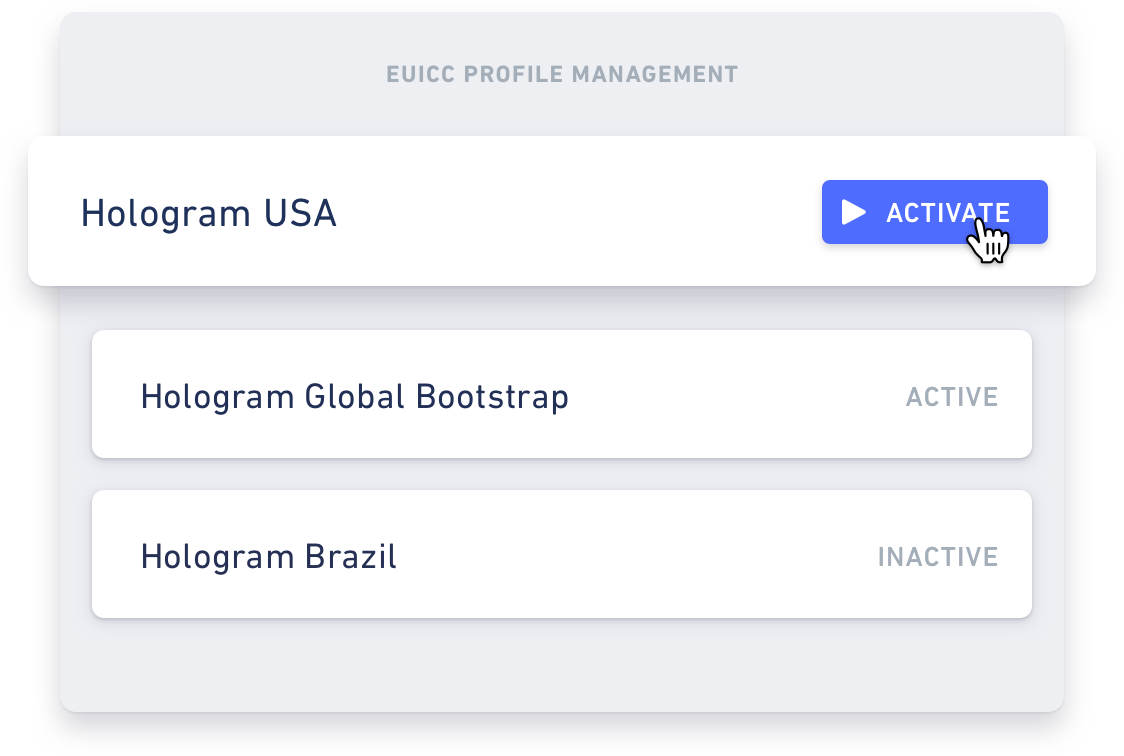
Hologram Hyper is an eUICC SIM platform that helps organizations future-proof IoT deployments and scale faster globally with over-the-air coverage updates.
Tailor coverage for devices by swapping cellular profiles over-the-air, without needing to change out hardware or SIMs.
Our eUICC-capable SIMs can be remotely updated and are available in both triple cut card and MFF2 embedded form factors.
Launch your fleet with Hologram Hyper and access our ever-expanding portfolio of connectivity partners.
Stop juggling multiple carrier partners.
Hologram Hyper lets you download new carriers and SIM profiles to your devices with a single click, optimizing coverage and costs even after devices are deployed in the field.

Simplify your supply chain using the same SIM card or embedded eSIM chip for every device, regardless of where it’s deployed.
With Hologram Hyper, the SIM hardware you install today can extend the life of your devices. Upgrade and optimize coverage down the line with over-the-air SIM updates.

With Hyper’s flexibility, Hologram can tailor coverage, performance, and cost to meet your business goals. As Hologram adds new connectivity partners, you’ll get access to an ever-expanding portfolio of local carriers.

With the Hologram Dashboard, you can test and deploy with Hyper quickly and easily.
With passengers' inflight entertainment expectations at an all-time high, avionics vendors need a way to download terabytes of movies, TV shows, and music during the short time every plane is on the ground. Juggling multiple SIM cards and dozens of carrier agreements to meet their airline customers' needs across regional markets is an operational nightmare.
With Hologram Hyper, vendor supply chains are simplified with a single piece of SIM hardware and a digital profile that can be adjusted based on each airline customer's location and needs. Avionics vendors have one platform to manage every connected aircraft, across dozens of local carriers. Hologram Hyper ensures the best connectivity experience that keeps passengers happy and while meeting all commercial and pricing goals.


As credit and debit card usage surges in new markets like Brazil, payment providers need reliable cellular connectivity for point-of-sale devices that meets the complex local telecom regulations and privacy requirements.
Hologram Hyper can bridge access across multiple regional providers, matching the right profile for each region. Within a single platform, payment providers can scale their network across different markets seamlessly. There's no SIM card juggling, multiple carrier agreements to manage, and no need to integrate with various cellular management platforms. Hologram is always expanding our network, and with over-the-air profile updates, we can ensure devices have the best coverage at the best price in each market.
Lorem ipsum dolor sit amet, consectetur adipiscing elit. Suspendisse varius enim in eros elementum tristique. Duis cursus, mi quis viverra ornare, eros dolor interdum nulla, ut commodo diam libero vitae erat. Aenean faucibus nibh et justo cursus id rutrum lorem imperdiet. Nunc ut sem vitae risus tristique posuere.
A multi-SKU cellular IoT deployment uses separate SIM hardware SKUs for different connectivity regions and use cases. This requires additional coordination at time of manufacturing and deployment of devices to the field. Also, different SIM SKUs may each require a separate connectivity management dashboard or integration.
A multi-SKU cellular IoT deployment uses separate SIM hardware SKUs for different connectivity regions and use cases. This requires additional coordination at time of manufacturing and deployment of devices to the field. Also, different SIM SKUs may each require a separate connectivity management dashboard or integration.
Hologram Hyper is an eUICC SIM and platform that helps organizations scale faster across markets and simplify their deployment process. Using Hyper, Hologram can remotely update coverage access on eUICC capable SIM cards.
Hologram Hyper includes the following components:
eUICC-capable SIMs
SIM cards with eUICC technology that enable new over-the-air connectivity profile management communications
eUICC Remote SIM Provisioning (RSP) platform
Platform that stores connectivity profiles and orchestrates communications to eUICC SIMs
eUICC connectivity profiles
eUICC enabled SIM profiles that can be downloaded/loaded onto eUICC SIM hardware
eUICC stands for embedded universal integrated circuit card. This is the technology that allows a SIM card to enable more than one subscriber profile over its lifecycle. (Carrier “subscriber profiles” indicate that a device has an account and can work on their network.) If your SIM card is eUICC-enabled, you can switch between cellular carrier profiles without ever needing to physically swap out the SIM card.
eUICC is the software that makes this possible. But for eUICC to work, you must use the right hardware — in this case, an eUICC SIM card that can support all the necessary profile management operations and additional memory.
Basically, eUICC SIMs act as a digital wallet that lets you use several different “credit cards” (or subscriber profiles), all on the same eUICC SIM card.
Hologram developed Hyper, our eUICC offering, to give M2M users more flexibility with their devices. Hologram handles all the technical integrations so that companies can use eUICC-enabled devices anywhere, with any of Hologram’s 550+ carrier partners. This simplifies their supply chains and extends the life (and usefulness) of their devices.
A UICC-enabled SIM limits you to a single default profile, which is placed on the SIM card at the time of manufacture. This profile can never be changed. If you want to switch carrier profiles, you must replace the entire SIM card within your device.
1. An eUICC-enabled eSIM card is manufactured by an accredited eSIM manufacturer. This card must be made with enough on-chip memory to support the eUICC OS (installed at manufacturing) and multiple profiles (installed later).
2. The eUICC-enabled eSIM is installed in a device, often soldered directly onto the printed circuit board itself.
3. Remote SIM Provisioning (RSP) technology lets you download, update, and enable different connectivity profiles on the eSIM. Hologram does this by sending an SMS directly to the eSIM’s eUICC operating system.
4. The eUICC-enabled eSIM then communicates with the cellular module and connects with Hologram’s eUICC platform to download the new connectivity profiles.
5. The eUICC-enabled eSIM and Hologram’s eUICC platform connect to confirm that the new profile has been successfully enabled.
A true eUICC solution is more than just the software or the SIM cards. Rather, M2M manufacturers who want to use eUICC in their devices should look at how all the elements work together. eUICC connectivity begins with the eUICC chips used in manufacturing and includes several software components.
Hologram simplifies eUICC-enabled connectivity by handling all the tech integrations:
• eUICC-enabled SIM manufacturing
• eUICC operating system
• eUICC-ready connectivity profiles and commercial agreements
• eUICC Remote SIM Provisioning (RSP) Platform
Think of UICC as an individual credit card with a set interest rate. When selecting a credit card, you had to decide which benefits are most important to you: cashback, miles, points, flexible terms, and so on. You can switch to another card later to get different benefits, but it’s kind of a pain — especially if you set up all your bills to auto-pay.
eUICC SIMs act more like a digital wallet that holds several credit cards. You can easily switch between cards to get the most advantageous benefits: use the one with fuel rewards when you’re gassing up your car, the one with no foreign transaction fee for international travel, or the cashback one for big-ticket purchases. For cellular IoT, that means you can choose the carrier profile that meets your connectivity needs, such as localized coverage, higher data traffic, or tailored pricing.
eUICC gives you more flexibility and choice, while UICC limits your options.
An eSIM is the embedded SIM card (the hardware itself) that supports eUICC (the software profile). eSIMs are actually available in multiple form factors, including 2FF, 3FF, 4FF, and MFF2. An eSIM is ideal for IoT devices that may be exposed to harsh conditions because it can be soldered directly to the board and vacuum sealed to minimize exposure. This soldering also allows for smaller form factors with fewer pieces. If you are developing a device that needs to last, an eUICC-compatible eSIM can ensure long-term usability. Read more about what an eSIM actually is and how eSIMs are used.
Not necessarily. Many eUICC SIM suppliers are simply manufacturers that assemble the silicon eUICC chips in different form factors and load the profiles generated by different carriers. They may be able to introduce you to the right people at a carrier, but they typically do not handle the connectivity service, nor do they offer user-facing dashboards and tools to help manage your deployment.
Hologram handles the entire process, from working to manufacture eUICC SIMS and negotiating with carriers through tech integration and ongoing support. We are constantly working to improve coverage options, performance, and flexibility for your organization.
All eUICC platforms and SIM manufacturers are required to be accredited to GSMA standards. However, you may need additional custom integrations and testing before your devices can properly perform eUICC operations for profile management. You will also need to negotiate agreements with your chosen carrier(s) and integrate their profiles into your eUICC platform. Hologram takes care of all that back-end configuration and negotiation so that your eUICC-enabled card works with all the providers we work with. (That opens up 550+ carriers worldwide and counting.)